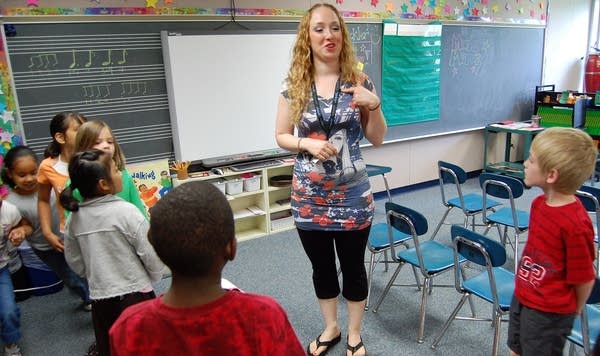School officials ponder funding, policy changes in budget
Go Deeper.
Create an account or log in to save stories.
Like this?
Thanks for liking this story! We have added it to a list of your favorite stories.

Education officials across the state spent the day poring over the $13.6 billion dollar K-12 education budget bill that Gov. Dayton signed into law Wednesday.
The central provision of the bill is a $700 million delay in state aid payments for schools, a critical and controversial element for balancing the budget. School districts will need to figure out how to manage that funding delay -- which they've had to do before.
Think of the delay in schools' state aid payments this way:
Your boss says to balance the company budget, she needs to borrow money from your paycheck. She'll pay you 60 percent of your salary this year, and repay the other 40 percent next year.
Turn Up Your Support
MPR News helps you turn down the noise and build shared understanding. Turn up your support for this public resource and keep trusted journalism accessible to all.
Meanwhile your bills are still the same, so you'll likely need to borrow money to meet all your obligations. And even though you'll get all your money next year, you're on the hook for loan interest payments in the meantime.
That's the situation Northfield School District superintendent Chris Richardson is in because of the school payment delay.
"That's interest that we pay out, for which the taxpayers basically get nothing back," Richardson said. "It's money we can't spend on programs and kids because we're having to spend it to pay interest."
This isn't the first delay Minnesota schools have dealt with. Last year, 30 percent of their payments were put on hold.
"That's interest that we pay out, for which the taxpayers basically get nothing back."
The K-12 bill aims to offset those interest payments by paying school districts an extra $50 for every student they have enrolled this year. It'll go up another $50 next year. However, 40 percent of that new money will get delayed as well.
In addition to the payment delay, the education bill signals the end to a decades-old effort to integrate Minnesota schools.
The state sends tens of millions of dollars every year to one-third of Minnesota school districts to foster interactions between students of different races and ethnicities.
The Republican-led Legislature tried to scrap that program, and instead spend the money on closing the achievement gap among students. But under the final bill, the integration program was extended for two more years. What it becomes in the future will be decided by a task force.
James Burroughs, the director of equality and diversity for the Minneapolis School District, expects that will change how the district deals with integration. His school district gets $18 million a year under the current program.
"I'm looking forward to the opportunity over the next couple of years to look at those things, strategize differently, and make sure that we're first and foremost achieving academic success for all students in Minnesota," said Burroughs.
School officials are trying to catch up with all the policy changes written into the bill since the budget deal was announced late last week.
There are provisions for more frequent and intensive teacher evaluations that take student success into consideration. The bill also requires new teachers receive mentoring and coaching from their more experienced counterparts.
Meanwhile, the K-12 bill also waives some requirements of schools, like setting aside money for staff development and tracking home-schooled students. It also ends penalties for schools that don't have teacher contracts settled by Jan. 15 each year.
Charlie Kyte, who lobbies on behalf of the state's superintendents, says that will save schools money.
"Taken together, they sort of uncuff our hands a little bit so we have more flexibility to run the school districts, to make them work a little bit more efficiently in this tough economic environment."
The education bill carries several implications for the state's charter schools.
It gets rid of some funding that charter schools have come to rely on, such as assistance with lease payments to rent facilities, and payments to new charter schools -- as much as $50,000 a year -- during the first two years they're open.
Eugene Picolo, who represents charter schools at the Legislature, says that could require some schools to make cuts.
"When you put all of these things together, there may be some schools that are pushed very close to the edge or go over the edge," said Picolo.
The education bill does try to alleviate some of the burden of the school payment shift for charter schools. Since charters can't borrow money as cheaply as regular districts, they'll be first to get their delayed payments next year, saving them money on interest.
Dear reader,
Political debates with family or friends can get heated. But what if there was a way to handle them better?
You can learn how to have civil political conversations with our new e-book!
Download our free e-book, Talking Sense: Have Hard Political Conversations, Better, and learn how to talk without the tension.




